Art reviews: Norman McBeath | Waistel Cooper | Iron | City in Contrast
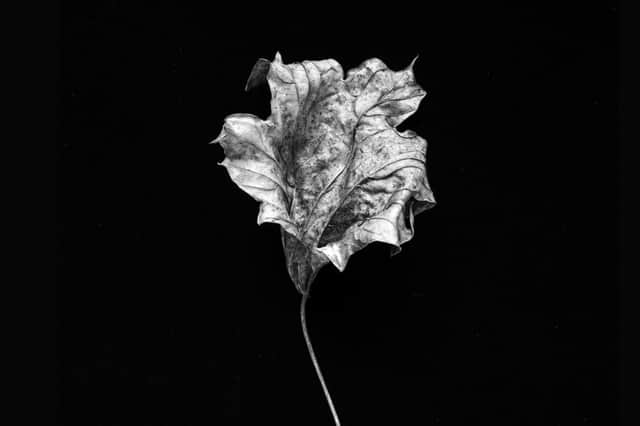

Norman McBeath: Perdendosi, Fine Art Society, Edinburgh *****
Waistel Cooper: Part I, Fine Art Society, Edinburgh ****
Iron: Translating Territories, Royal Scottish Academy, Edinburgh ***
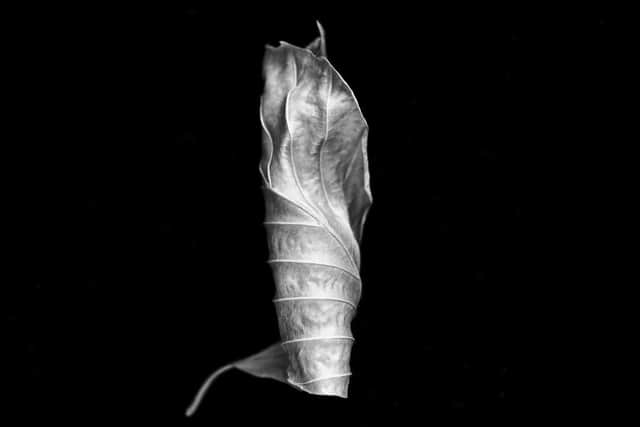

City in Contrast, Open Eye, Edinburgh ****
Advertisement
Hide AdFrom green shoot, to leaf, to wide green canopy, to gold and finally to a skeleton blowing in the wind, leaves present each year a glorious, dramatic reenactment of the cycle of life to which all living things are subject. In his exhibition at the Fine Art Society, launching a portfolio titled Perdendosi, photographer Norman McBeath has focused on the leaf in the last stage of this cycle, when, fallen, it dries to a weightless skeleton of its former self, curled, fragile, and near transparent.
This work was inspired in part by lockdown, a time, he says, "when the daily news of the relentlessly increasing deaths and infections across the world left me shocked and frightened.” These photos don’t seem to reflect this state of mind directly, however. They seem more reflective, more melancholy than shocked or alarmed. His title, Perdendosi aptly deploys a musical term for a gradual dying away, the quiet, almost imperceptible ending to a piece of music when drama gives way to reflection.
The show consists of just 12 portraits of individual leaves in this last, fragile state. Each is set against a black ground. There is nothing else at all, but McBeath has nevertheless done something remarkable. A question always lurks behind photography: when does it become art and cease to be just snapshot or documentary? With millions of photos taken everyday, some must be very beautiful, but are they a willed creation or does the sheer number mean some must be accidental masterpieces? McBeath has ended that argument decisively as far as his own work goes by making photographs where the art is manifest and the result is a set of exquisite objects. The photographs are described as digital prints, but that bald description conceals a kind of magic. The pictures are black and white and just snapshot size, but they have a real physical presence. It is there in the intricate delicacy of the leaves captured with perfect clarity and apparently suspended in a velvety, light-absorbing black. Early photographs sometimes have this wonderful physical quality, but to achieve it by using modern methods is something of a miracle.
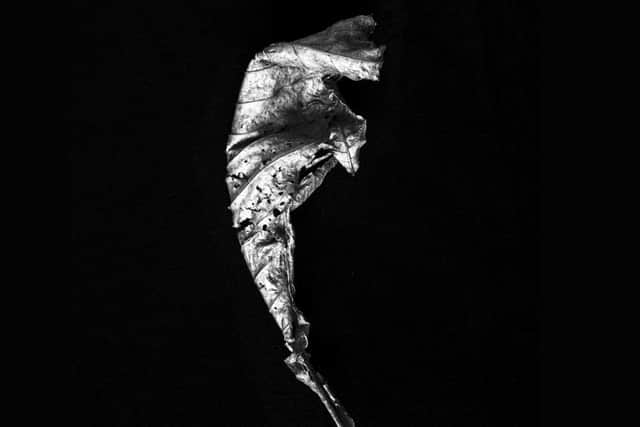

The publication is also accompanied by a text by Edmund de Wall. It is a beautiful soliloquy on leaves ranging across Shakespeare, Goethe, Ruskin, Walter Benjamin and others, all reflecting on leaves, but also on melancholy. De Waal quotes the speech in Twelfth Night, for instance, that begins “If music be the food of love,” and ends with Shakespeare’s account of perdendosi, “That strain again. It has a dying fall.” He also describes how Goethe wrote the Wanderer’s Nightsong under an oak tree. Schubert set it to music. The Nazis cut the forest where the oak tree stood to build Buchenwald, but left the tree in the middle of the camp. It was burnt to the ground by allied incendiary bombs. The DDR then cast its stump in concrete and so, de Wall ends, it is a tree with no leaves.
It is no surprise that in their apparent concentration of meaning, Mcbeath’s jewel-like images should inspire such reflections. They are an oblation, says de Waal, an offering to the gods. More simply they are a memento mori, but also a quiet and fitting testimony to the losses we have shared collectively and individually, whether through bereavement, loss of livelihood, of society, or simply of peace of mind over these last two awful years.
The distillation down to a some kind of essence in McBeath’s photographs finds an echo in the purity of form in Waistel Cooper’s pots which, also in the Fine Art Society, provide a fitting companion show. Cooper was born in Ayr in 1921. Somehow when he was only 17 he went to study at Hospitalfield, where James Cowie was the teacher, although it was then strictly a postgraduate school for the four Scottish art schools. Enlisted in the Artists’ Rifles, in 1943 Cooper was invalided out and then went to Edinburgh College of Art. In 1946, invited to show his work in Iceland, he went there and, meeting an Icelandic potter, he had an epiphany that turned him from painter to potter.
Advertisement
Hide AdHe stayed in Iceland till 1950 and then set up a pottery first in Somerset and then in Devon. During the fifties he made some delightful earthenware pots with spirited figurative decoration, somewhat in the manner of Picasso. The show is based on a single collection, however, and the Fine Art Society has decided to split it into two parts, one in Edinburgh the other in their sister gallery in London.
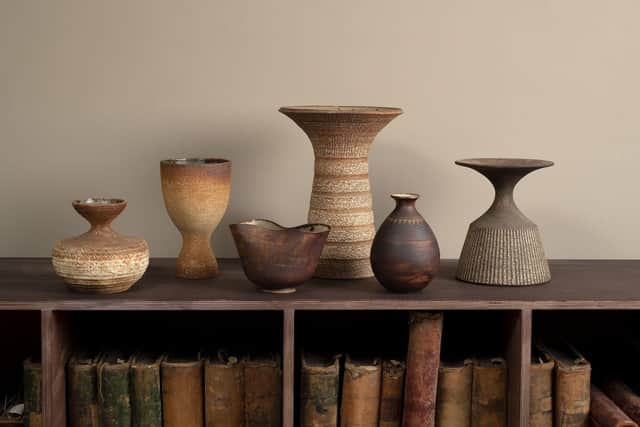

The representatives of this charming early manner are only view in the south. They will apparently come to Edinburgh later on, however. What is on view here is a selection of the stoneware pots that Cooper made from the late fifties onwards. (He died in 2003.) Some are rough textured, others have a high glaze. All are in earthy browns and greys but with here and there perhaps a hint of red, green or blue. In them all, form and texture are in perfect harmony.
Advertisement
Hide AdWhen he strays from the simple classic shapes of urns, jugs or baluster vases, he is less convincing, but in his best work, the purity of shape and its unity with the surface glaze is absolutely lovely. There is even a leaf motif to connect to McBeath’s work and to de Waal’s poetic commentary. One baluster lamp seems to have been wrapped in ferns in the kiln. Their shadow is burnt into the glaze.
In Iron: Translating Territories at the Academicians’ Gallery in the RSA, work by an international group of artists has been assembled and, among them, Clare Flatley also does interesting things with ceramics. She cites alchemy among her inspirations and uses iron glazes to make ceramic objects that look exactly like iron – not quite base metal turned into gold perhaps, but ingenious all the same. Gordon Munro who has curated the show has a very nice assembly of simple geometric forms, rust-red and very much iron without compromise. He also has the rather charming notion that iron has been constantly recycled over millennia in a constant metamorphosis and his art may go that way too.
Euan Robertson catches something of the essential feel of iron in a combination of iron spikes and bricks. Michal Staszczak has made some striking surreal figures from cast iron. Others, however, do seem to stray off the point and in the end whether the exhibition will really “unveil diverse understandings of the physical world around us and explore the creative potential and complexity in this singular material,” as the blurb claims, I am not so sure.
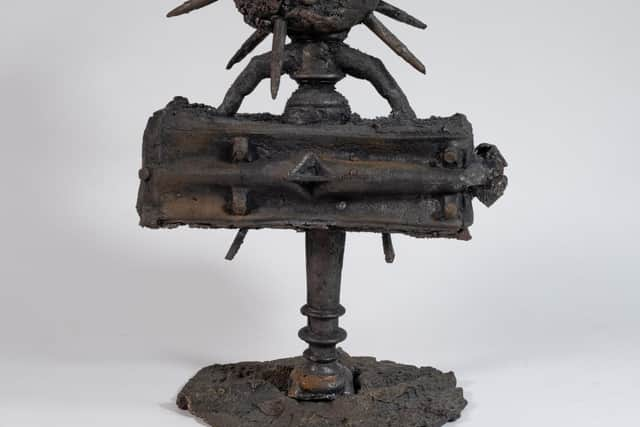

Finally the Open Eye has spotted how Edinburgh is a theme in contemporary Scottish art and, in City in Contrast, it has brought together an intriguing group of works by John Bellany, Barbara Rae, Henry Kondracki, David Foster, Ann Ross and others to prove it. Kondracki paints Holyrood by poetic moonlight, while Barbara Rae’s painting of fireworks above the Castle is very striking. Ann Ross’s delicate watercolour of Victoria Street is at the other end of the dramatic scale, but both capture characteristics of a diverse city as do others here.
Norman McBeath and Waistel Cooper until 18 February; Iron: Translating Territories until 6 February; City in Contrast until 5 February
A message from the Editor:
Thank you for reading this article. We're more reliant on your support than ever as the shift in consumer habits brought about by coronavirus impacts our advertisers.
If you haven't already, please consider supporting our trusted, fact-checked journalism by taking out a digital subscription at https://www.scotsman.com/subscriptions